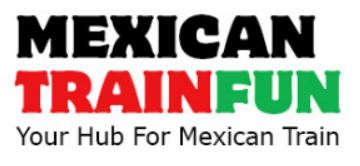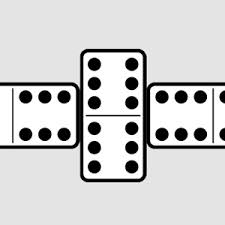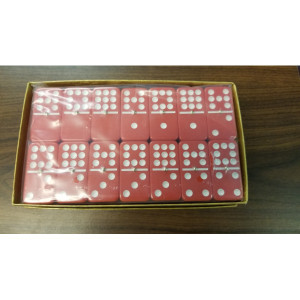 Loading... Please wait...
Loading... Please wait...- Home
- Mexican Train Rules
Categories
Mexican Train Rules
Mexican Train Rules
 MexicanTrainFun.com's rules are based on the most popular and challenging version of the game. These are the rules used at our train events & tournaments
MexicanTrainFun.com's rules are based on the most popular and challenging version of the game. These are the rules used at our train events & tournaments
Game Objective
The goal of Mexican Train is to be the first player to lay down all of your dominoes. Whatever tiles are left in your hand count against you, so play strategically and try to get rid of the high-numbered tiles. Play moves clockwise from one player to the next.
The Start Player and the First Tile
Shuffle the dominoes; face down, on the table. We recommend that before the round starts, all players look for the starting tile. The player who finds the tile starts the game. They place the double-12 in the center of the hub. This domino serves as the "engine" for the round.
The remaining dominoes are turned face down. This supply is known as the boneyard. Then, each player takes the appropriate number of dominoes (see below) and stands them on edge, so that they can see the faces (the side with the pips) but their opponents cannot. We strongly recommend using domino tile racks to make this easier for you and so your dominoes don’t fall down.
Recommended Tiles:
- For 2-3 players, use a double-9 set - each player takes 8.
- For 4-6 players, use a double-12 set - each player takes 12.
- For 7-8 players, use a double-12 set - each player takes 10.
- For 9-12 players, use a double-15 set - each player takes 11.
- For 13-14 players, use a double-18 set - each player takes 11.
The First Turn
The start player now starts to build a train (a single row of dominoes) starting from the center domino and moving toward the player. The end of the domino placed near the engine must match the engine's double number. (Example: If the engine is a double-12, the end of the domino placed near the engine must be a 12. The other end can be anything at all.)Taking turns in a clockwise direction, the other players do the same.
Building Trains
If a player cannot start a train on the first turn, they can draw from the boneyard pile. If they pick the needed domino (in this case the double 12- they can immediately play it. We call this the “Golden Domino” – when you are lucky enough to draw the domino that is needed. If they don’t draw the tile they need, they place a marker (train) where a domino would have been placed to indicate that they could not start a train.) On the second turn and all subsequent turns, any player can play dominoes in marked areas.
MEXICAN TRAIN DOMINOES RULES
MexicanTrainFun.com Version
After Player 1 plays a domino on their train, it is Player 2’s turn to play on their train. If any player doesn’t have a 12 in their hand then they must keep all their dominoes and draw one from the boneyard. If a player cannot play, then they must put a train marker on the hub at their location to indicate that anyone can play on their train. At this stage most, if not all, the players will build their own trains, a personal playing area. The trains will lead out from the engine towards the player that laid them. This formation is known as the roundhouse. Eventually it will be player 1’s turn again. Each player, in turn, places a tile to make the trains longer and to try and empty their hand. When you cannot go you must draw one domino from the boneyard unless the boneyard is empty. If you can play, you must place a tile.
Options for Play: 1) Play on the end of your own train. If you cannot play from your hand you can draw from the boneyard and can play that tile if it matches. If it doesn't match you place your train marker on the end of your own train. This opens it to other players. When you play on your own train again, take the train marker off your train and no one else can play on it. 2) If you cannot play on your own train but somebody else has their personal train marker in play then you can play on the end of that train. 3) You can also start or play on the Mexican Train. It must start with a twelve (EX: for round 1) You play one domino to start it. From then on it is open season on the Mexican train, anyone can play on it at any time. Only one Mexican train is allowed per game, but it can be started at any time.
 Playing A Double Domino
Playing A Double Domino
If a player plays a double at the end of a train then they announce “Double.” They also must ANSWER the double. That means if it’s a double 6, they place the double 6 and MUST PLACE ANOTHER TILE with a 6 with the double at the same time. If they can't they draw from the boneyard. If they draw and pick the tile they need, in this example “6”, they can immediately play the tile on their train to match the double. If they can’t answer their own double after picking in the boneyard, they must place their train marker on their train. The next domino by the next player must be played at the end of the train showing the double. If you cannot play against the double you must draw from the boneyard. If you still can’t play, you must pass. If you pass you don’t have to put your marker on your train.
Variation- Answering A Double to Form a Chickenfoot
Instead of answering a double with only one tile, we STRONGLY RECOMMEND you answer with 3 dominoes. Play continues until the double is answered with three dominoes, forming a chickenfoot. Many people place a chicken on the double so players can see where the doubles are on the table.
VARIATIONS: We recommend that you only answer one domino on the Mexican Train (community train) vs. three dominos for a chickenfoot, this adds an element of intrigue and makes you think about the best play for your doubles.
The End of Play The last domino in your hand must be announced. You can announce by tapping your tile loudly on the table or by saying ”uno” loudly. If another player notices that you have one tile left and have not announced it then he can make you draw two tiles from the boneyard, unless it is empty. The player must announce this before the next player has drawn a tile. NOTE: Very people ever enforce this rule, it’s a friendly game, and it’s a tough call.
The round finishes when one player has no more tiles to play or when the game is blocked. Note: You are not allowed to go out on a double. If you play a double, you have to answer it to be officially out.
Scoring A player that empties their hand scores zero points. At this point all the other players score the total number of pips/ dots on the dominoes left in their hand. Usually, a series of games are played and whoever has the least points at the end of the series, wins the match. You don’t have to play all 13 rounds, you can end whenever you like.
After all rounds have been completed, the player with the fewest points wins. If there is a tie, the player who scored the most zero-point rounds wins. If there is still a tie at this point, the player with the lowest total in a round, other than zero, wins.
Rule Variance: Many people count a double blank as 25 or 50 points vs the recommended 0 points. This is up to your train gang, you just need to decide this at the start of the game
If a player is unable to play and the boneyard is empty, the player must simply pass and ensure that a marker is placed upon their train. Play continues until all of the available moves are played.
RECOMMENDED EQUIPMENT FOR PLAYING DOMINOES
Domino Sets
We recommend a set of double 12 dominoes for 2-8 players.
Choose either dots or numbers. We recommend numbers for maturing or younger players since it’s easiest to count and see. It’s best to get a set with an interactive hub & all the pieces.
Hub-Centerpiece
A standard flat hub is the most popular, we have MADE in the USA top quality hubs in red, white & black
Interactive Hub Plays sounds –“Choo” to announce your train and/ or “Chicken Sound” to announce a double
Domino Tile Holders
Choose wood or plastic, the plastic trays hold more dominoes (44) vs the wood racks which hold up to 30 dominoes.
Trains and Chickens
Trains mark when your train is up, we also recommend the train starter piece for the Mexican train.
Chickens are used when playing chickenfoot and marking a double. Train Starters and/ or Train Key chains mark the Mexican train.
Scorepad
Our USA made four color scorepads make it easy to keep score. They are available in double 12 or double 15 size.






